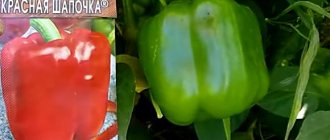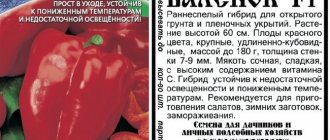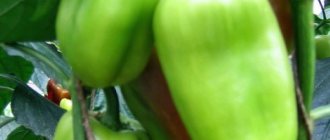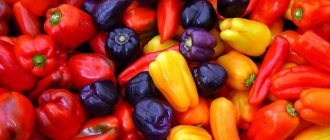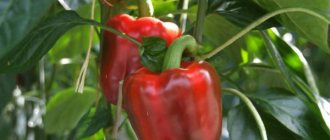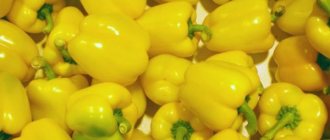Red cheeks are large-fruited peppers from Russian specialists from Agrofirm Poisk LLC. The official registration of the variety in the Russian Federation dates back to 2015. Over the course of several years, the culture has become widespread, as its creators adapted it for different climatic zones. In the article, the reader will find a description of the appearance and main qualities of the vegetable, and instructions for growing it.
Description of pepper Red cheeks
Red cheek pepper produces both male and female flowers. Its cultivation is possible in greenhouses or under film shelters, where there are no natural pollinators. The cold resistance of the variety allows it to be planted in open beds. Thanks to this, Red Cheeks pepper is recommended for cultivation throughout Russia.
Red cheek pepper is a sweet variety. The plant is medium-sized. Reaches a height of 50-70 cm. It is often formed in the form of a trunk with a spreading crown. The shoots are smooth, strong, with a large number of branches. Their color is light green. Over time, they darken somewhat and acquire a red-brown tint in the lower part.
The shoots are densely leafy. The leaves are large, elliptical in shape. The wrinkling of the leaf blades is weakly expressed. In healthy plants they are smooth, dark green in color with a noticeable glossy sheen. Pepper Red cheeks blooms with funnel-shaped flowers, medium in size. The petals are white, sometimes with a delicate pink tint. The flowers are mostly solitary, but occasionally they are collected in inflorescences of 2-3 pieces.
The appearance of the Red Cheeks sweet pepper is attractive and appetizing. The fruits are large. They have a cone shape, with pronounced ribbing. They grow up to 10-12 cm in length. The weight of one fruit is from 250 to 300 grams. At the stage of technical maturity, their skin is brown-green. As it matures, it acquires scarlet shades.
Red cheek peppers are thick-walled. The thickness of the walls in favorable conditions reaches 7-8 mm, on average its dimensions are 5-6 mm. The fruits are four-chambered with an average number of seeds.
Attention! This variety should not be confused with the sweet pepper Rosy cheeks. They are similar in characteristics, shape and color of the fruit. But the latter is much smaller. Its weight rarely exceeds 50 grams. But it consists almost entirely of juicy pulp.
Gardeners and chefs highly appreciate the taste of Red Cheek peppers. The pulp is fleshy and juicy. The taste is bright, with pronounced sweetness, a characteristic peppery taste and aroma.
Description and characteristics of the variety
Pepper Rosy cheeks belong to the category of early species. From the moment the seedlings are planted until they mature, 75-80 days pass. The bushes are powerful and strong, their stems grow up to 70-80 cm. They require shaping as they grow.
Sweet pepper produces fruits with the following characteristics:
- average weight 100-120 g;
- length 9-10 cm;
- diameter 5-6 cm;
- wall 7-8 mm.
- elongated shape;
- seed chambers 4;
- at the top there are forked dimples.
The variety is universal regarding the use of fruits and cultivation conditions.
Characteristics
Like all types of peppers, Red cheeks are not frost-resistant. It is planted in a permanent location only after the threat of return frosts has passed. But the variety is well adapted to low and high temperatures, as well as their differences. Tolerates moisture deficiency well. During short-term drought, it continues to bloom and form ovaries. But the fruits may not reach the sizes declared by the breeders.
Interesting fact! Many attribute the crop’s resistance to weather conditions to the fact that the variety belongs to the Siberian selection, since one of the official sellers of Red Cheeks pepper seeds is.
The Red Cheeks variety is mid-season. Pepper reaches biological maturity 120-130 days after germination. The beginning of mass fruiting occurs at the end of July or beginning of August. At the same time, 7-8 fruits can ripen on one bush. The fruiting period is long. In the long, warm autumn, bright peppers will delight you until the end of September.
Red cheek pepper has good yield. From 1 m² they harvest up to 6-8 kg. Feeding and timely watering during fruiting will help increase it. Whatever gardeners say, it is better to provide supports. The abundance of large fruits often breaks the branches of the plant. In addition, you need to regularly pick off ripe peppers, stimulating the formation of new ones.
Vegetable growers also like Red Cheek peppers for their high commercial qualities. It is stored for a long time in a cool place and is easily transported over long distances. If necessary, you can remove fruits at the stage of technical maturity. They ripen well during storage.
Bright color, thick walls and excellent taste allow Red cheek peppers to be widely used in cooking. It is great for preparing fresh salads, baking in the oven or grilling, and decorating dishes. For the winter, it is frozen, pickled, and used to make lecho.
Description of the best varieties of sweet pepper
Among the best representatives of sweet peppers, suitable for tasty, juicy and aromatic preparations for the winter, thick-walled, large, multi-colored varieties stand out:
- Bagheera,
- Bull,
- Gold of Siberia,
- Community,
- Cavalier,
- Bear,
- Solar,
- Orange Prince,
- rosy cheeks,
- Jaguar,
- Yatagan et al.
Bagheera
The cube-shaped fruits of this high-yielding variety are famous among gardeners for their rare beauty and excellent taste. The variety is mid-season; in 115 days, weighty peppers ripen - 130 g are guaranteed, but if you try, you can get fruits weighing 180-350 g. Depending on the degree of ripeness, the fruit changes its extravagant color from purple-black to red-chocolate. The bush is compact, not very tall (45-50 cm), but powerful: the harvest will always peek out from under the leaves. Bagheera can be grown both in open ground and under film covers. With proper care, the variety will delight you with a harvest of at least 1.2 kg per 1 sq. m.
Feel free to eat this pepper fresh, use it for canning, pickling, stuffing and lecho - the juicy fruits will give a rich taste to all your dishes.
Photo: Variety Bagheera
Bull
This mid-season variety is truly pleasing to the eye: the brightly colored fruits (from soft yellow to orange) seem to glow and play with a delicate pearl sheen. You will get large, thick-walled, cube-shaped and very tasty fruits that retain their attractive appearance for a long time.
The bush is strong and tall (50-70 cm), can be grown in open ground, and when protected the variety will produce at least 4 kg of yield per 1 sq. m. m. In just 100-110 days you will get peppers weighing 84-120 g. Bugai’s taste is considered rather neutral, so it is ideal for preparing multi-component preparations.
Photo: Pepper variety Bugai
Community
The variety is valued for its excellent taste and appearance of the fruits - they are long, elongated, glossy and have a rich color from dark green to dark red. The plant itself is spreading, tall and powerful, so it will require a lot of space in the garden bed.
The fruits are very large, measuring 12x10 cm and weighing 230 g. The variety performs well both in open ground and in protected ground. But if you grow peppers under film covers, you can easily get up to 3 kg of yield per 1 square meter. m. In order to collect fruits as early as possible, it is recommended to grow seedlings without picking.
Photo: Pepper variety Gromada
Gold of Siberia
Ripe bright yellow prism-shaped fruits with a glossy shine are valued by gardeners for their sweet taste and rich aroma. This mid-season variety can be grown in open ground or under temporary film covers, and if you do not pick up the seedlings, the harvest can be obtained at an earlier date.
The plant is semi-spreading, of medium height. The stem is branched, which means there are more fruits on it. They grow large (weighing about 220 g), with a wall thickness of 7 mm. From 1 sq. m you can harvest up to 5-6 kg of crop. Gold of Siberia peppers are good for fresh consumption and for use in home cooking, including canning.
Photo: Pepper variety Gold of Siberia
Cavalier
This early-ripening variety is zoned in the West Siberian region and is suitable for cultivation in open ground and under temporary shelters. For earlier harvesting, seedlings are not picked. Peppers grow cone-shaped, not very large (average weight 75-80 g), with a wall thickness of about 5 mm. Ripe fruits are painted in a beautiful red color with a glossy sheen and have excellent taste and aroma.
Bear
A medium-early ripening variety, valued for its compactness, high yield, sweet taste and beautiful appearance. The peppers are large (weighing about 130 g), cylindrical in shape, with tender and juicy flesh, from dark green to rich red.
By growing this variety in open ground, you will collect at least 1.8 kg per 1 square meter. m, but under film covers - all 3 kg of the crop. The fruits are very good fresh and are suitable for processing and stuffing.
Photo: Variety Bear
Orange Prince
The large fruits of this variety (weighing 170 g) attract with their bright orange color. In addition, their flesh is juicy and very sweet, so peppers are good both fresh and for any homemade preparations.
The plant is spreading, tall, early ripening, suitable for growing in open and protected ground. The variety produces 2-3 kg of yield per 1 sq. m.
Photo: Variety Orange Prince
rosy cheeks
The fruits of this variety are small (only 40-50 g), but have an interesting cone- or heart-shaped shape. In addition, the variety is distinguished by its high yield: it produces 4-5 kg per 1 m2 if grown under film covers, but plants can also be planted in open ground. The variety is early ripening, the fruits ripen quickly and become edible already with a greenish-white color. Ripe peppers have a rich dark red color.
Solar
The fruits have excellent taste, not very large (average weight 77 g), interesting colors: from yellowish to dark red. Even when grown in open ground, you can collect up to 2 kg of fruit from 1 square meter. m. When using shelters, the harvest will, of course, be greater. Peppers are tasty fresh and are great for home cooking, canning, stuffing, and making lecho.
Pepper variety Thomas F1
Ripe fruits of juicy red color have an elongated cylindrical shape and weigh on average 180 g. The hybrid is mid-season, suitable for planting in film greenhouses and open ground. At the same time, when growing it under film covers, you can collect at least 3 kg per 1 sq. m.
To obtain an early harvest, it is recommended not to pick seedlings. The peppers are sweet, with tender flesh; They can be used both fresh and in homemade preparations.
Photo: Variety Thomas F1
Fat Baron
Fully ripe fruits of this variety are dark red in color. Their aroma is strong and the skin is tender, so using these peppers in homemade preparations is a pleasure. The bush is closed, low-growing, ideal for growing in small areas. When grown in open ground, it is easy to harvest up to 3 kg of crop from 1 square meter. m.
Jaguar
By growing this variety, you will get large yellow peppers weighing up to 230 g, prism-shaped, with a glossy shine and excellent taste. Even in open ground you will collect at least 3-4 kg of fruits per 1 square meter. m. The variety is valued for its fruits of universal use: they are good fresh, for canning, stuffing and for preparing multi-component preparations, including lecho.
Rules for planting peppers Red cheeks
Red cheek peppers are grown using the seedling method. Sowing of seeds in the middle zone begins in the second half of February, if the seedlings are to be transplanted into a greenhouse. For open ground, peppers are sown in mid-March. By the time of planting, 60-65 days should have passed after emergence.
Planting seedlings
Red cheek pepper seeds are sown either in containers or directly in separate containers. The soil is suitable either purchased with a large amount of organic matter or prepared independently from garden soil, humus and sand.
Attention! Red cheek peppers are a cultivar. It is enough to purchase a bag of seeds once. In the future, planting material can be harvested independently. However, such seeds should be treated with a solution of potassium manganese or Fitosporin before planting.
The seeds are laid out on the surface of moistened soil and sprinkled with a layer of soil 1-1.5 cm high. They are moistened with a spray bottle, covered with film or glass and left warm for germination.
Red cheek pepper seeds have good germination rates. All varieties do not like picking. Therefore, many vegetable growers prefer to plant seeds immediately in separate containers. To be safe, they are pre-germinated by placing them on a napkin moistened with a solution of a growth stimulator.
Growing seedlings
After emergence, seedlings need:
- in irrigation with settled water at room temperature;
- diving into cups at the stage of 4-6 true leaves;
- fertilizing with complex fertilizers;
- good lighting;
- hardening before transplanting into the ground.
Planting red cheek pepper seedlings and caring for them is simple, but requires care and attention.
Transplantation into the ground
Peppers are transplanted into the ground during May. In the middle of the month in greenhouses, and in open ridges towards the end of the month, or even at the beginning of June. It is necessary for night temperatures to settle within 8-10 degrees Celsius so that the threat of return frosts passes.
Rules for caring for peppers Red cheeks
During the growing season, pepper Red cheeks:
- water at least 2 times a week in the early morning or evening hours after sunset;
- weed, loosen and renew the mulch layer;
- They are fed with organic fertilizers before fruiting, and then with potassium fertilizers, in order to increase the period of fruit production.
When growing peppers in a greenhouse, it is regularly ventilated. Experienced gardeners recommend forming bushes. Either in the form of a trunk, removing all the lower shoots, or growing a crop of 2-3 stems. Otherwise, there is a possibility of thickening of plantings and overloading of plants with fruits.
Description of the variety
Red cheek pepper is a medium-sized crop. The height of the stems on the bush ranges from 50 to 75 cm. The leaves are small, dark herbaceous in color. At the same time, pepper can produce 7 fruits.
When ripe, the vegetable gradually changes color from rich green to burgundy red. The walls of the perisperm are 5–6 mm thick. Peppers are classified as cylindrical in shape. However, it is worth noting that the fruits taper towards the bottom (see photo). The weight of a mature vegetable reaches 250 - 300 g. Each unit contains many small round seeds located in 3 - 4 compartments.
Attention! Some sources indicate that the fruits reach a weight of more than 300 g and have walls of 8 mm. This information is not incorrect. A gardener is able to obtain peppers with these characteristics with careful care and stable favorable environmental conditions.
| Type of growth, bush height | Standard, 50 - 75 cm |
| Ripe fruit color | Burgundy red |
| Planting scheme | 30x70, 40x60 cm |
| Weight, length and shape of the fruit | 250 - 300 g, more than 12 cm, cylindrical |
| Ripening period, yield | Mid-season (120 – 130 days), from 6.8 kg/m2 |
| Drop off point | exhaust gas/greenhouse/greenhouse |
| Diseases | Necessary standard measures for protection against diseases and pests |
| By type of use | Universal |
| Flowering type | Mixed |
Diseases and pests
Red cheek pepper has been cultivated for a short time. Breeders position it as a variety with high immunity. Gardeners occasionally note diseases such as gray mold, Alternaria and late blight. It is quite difficult to cure plants without the use of fungicides.
Dangerous pests include aphids, thrips, and slugs. They try to keep the greenhouses and garden beds clean and regularly inspect the plants. Timely pest control will help avoid the use of strong chemicals.
Reviews
The variety is distributed by many sellers, but reviews about it are difficult to find. Most often, pepper is mentioned by experienced vegetable growers when listing crops with thick-walled fruits suitable for growing in unprotected soil conditions. For example, agronomist Yulia Belopukhova, in her article on successful varieties and hybrids, classified the vegetable as a plant with large fruits. She recommended using it in salads and sandwiches.
Red cheek pepper is a crop that can produce a stable yield with standard care. Consumers appreciate it for its beautiful appearance, abundance of vitamins, and pleasant taste.
